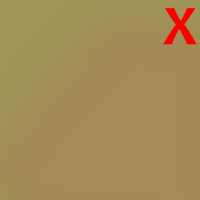Free Marks
Unlike many other ARPGs, World of Gaia only has two free markings- Lightening and Darkening. They are effectively the same marking, albeit one is lighter than the base and the other is darker than the base. You are allowed to have both on the design at the same time. This allows for small areas on the Kiji or Tally, namely on the face and feet, to have some small uniqueness.
While you can adjust the shades (value) of the base coat in these areas, you can't hue shift more than 5% on your program's Hue slider. However, you can lighten all the way up to white, or darken all the way to near-black, so long as the lines remain visible. The only exception to this rule is when a spirit has an Additional Base Coat, in which you are allowed to have Lightening or Darkening be from other coat colors than the base. (For example, a Fruity kid would have to have Lightening and Darkening follow the hue shift rule, but if you had a Waterlogged Nighted Kiji with the coat being black, you could have lightening make the insides of the ear blue.)
Below are the ranges allowed for Lightening and Darkening in the blue.
Why do you only have two free marks that don't allow for much?
Unlike other ARPGs, which generally have a small handful of free marks, we only have two because every spirit comes with Energy. Energy is a pretty freeform marking, and allows for a large handful of possible designs. Many other ARPGs have genos with much fewer markings on them than us, and sometimes even no marks, so free marks allow people to still have some detail on their kids. Since we have Energy, we do not have that problem on our kids with less markings.
Additionally, this game makes it easy to get trait and marking applicators which you can apply to your kids, so even if you have a very simple spirit you can easily get various applicators to add to the design.
Nuances & Shading
In case you were unaware of what nuances are, nuances are, in the context of color, subtle variations in shades, tones, or hues. For example, a slight variation in the saturation or lightness of a color can create a different nuance. Subtle shading of a design can also be considered a nuance. Below are some examples of incredibly subtle nuances:




World of Gaia does not allow nuance coloring or shading for Kijis or Tallies (However we do allow it for Centaurians!). This is to help us colorpick or see markings better. Granted, if there's a single point difference in a color through the body, or the difference is so subtle you cannot tell with your eye, it may be allowed, but if it is noticeable or obvious or picked up by color picking then it will be rejected. Additionally, there are some markings that allow for nuances or gradients in the marking itself, but this is only for the marking.
Additionally, you may not shade or shine the main bodies (unless you have the Shiny body trait, which only allows shine and not shadows). You may however add subtle shading and/or shining to the claws, hooves, and teeth, as well as any flesh. Charms can also be shaded or shined. For any metallic traits, like Golden and Silver bones, or even the rim on traits like Water Jug, you may do more drastic shading and shine to make it obvious it's metallic.
Bones
Bones includes the hard-looking (or certain keratinous-looking) parts of the body such as claws, hooves, teeth, horns, and any body or back spikes.
There are many different colors you can have your bones be:
- Natural White: Bones that are a natural white color are allowed to be a white or nearly greyscale pale brown grey color. They cannot be 0% saturation and 100% value white unless shading is present, and may only tint in the hotter pink to yellow range, not the cooler green to purple range.
- Natural Yellow: Bones that are a natural yellow color are allowed only to be a yellowed off-white and must be fairly pale, but still have obvious yellow tinting. They may not be so yellow to appear "rotten" or being mistaken as a mutation such as Painted Claws/Hooves or Golden Bones.
- Natural Grey: Bones that are a natural grey color are allowed to have a light to mid grey at the base or inner part of the bones ONLY. The outer bits must still be natural white or yellow. They cannot be entirely grey or a darker grey, but may have a subtle desaturated pale brown tinting.
- Natural Pink: Bones that are a natural pink color are allowed to have a light pale pink at the base or inner part of the bones ONLY. The outer bits must still be natural white or yellow. They cannot be entirely pink and must be fairly desaturated.
- Same Base: Besides the natural colors, bones can be the same color as the base. This means that when color picking, the base and bones should be the same hue, saturation, and value, though allowance is given to be off by a couple points.
- Similar Base: You are also allowed to have the bones be lighter or darker than the base by a few shades or tints. This means that when color picking, the base and bones should be the same hue and saturation, but value can be slightly lighter or darker, but not by too much. Allowance is given for saturation to be off in the case of lightening if the value is already as light as can be.
Bones are NOT allowed to be black without the Black Bones mutation, or the base coat already being black!
Additionally, bones can be affected by Energy if one has Keratin Energy. Bone Mutations such as Painted Claws/Hooves, Golden/Silver Bones, Glowing Bones, etc can also overwrite the color of the bones, though please pay attention as some mutations can only affect certain bones or must affect all.
Can Bones Have Multiple Colors?
Yes! Bones can have natural streaking or fades to them, as long as they remain within color ranges to the base coat or being of the natural colors. This streaking or fade however can only be one color shift and cannot appear as metallic shines or unnatural. Additionally, you cannot have one claw/tooth be one color then another be another, or have patches of color affecting only a portion of a claw or tooth; all claws or all teeth should be affected the same (Unless affected by a mutation or marking).
So Markings Can Affect Bones?
Yes! If a marking touches the area connecting to a bone trait, the bone can be affected by said marking. A good example of that is Skew and Piebald, which can allow for spotting or odd colored claws or other bones, or markings that come from the legs such as Dipped or Boots allowing the 'natural to the base' listed above to be 'natural to the marking'.
Flesh
Flesh includes the paw pads, mouth, nose, and the small triangles of flesh in the corners of the eye. The inner ears are NOT counted as flesh.
There are many different colors you can have your flesh be:
- Natural Pink: Natural pink flesh may not be too saturated, and can be anywhere from super pale to a darker desaturated magenta. It can have subtle reds mixed in, but no other colors.
- Natural Red: Natural red flesh can be a fair bit saturated, and can be tinged with pinks or lighter reds. It cannot have purples or oranges/browns mixed in.
- Natural Brown: Natural brown flesh must be a darker color and must be fairly desaturated. It cannot appear orange, but can have bits of darker near blacks mixed in.
- Natural Black: Natural black flesh cannot be so dark that you cannot see the lineart. It can have browns or dark greys mixed in, but must be mostly black.
- Natural Blue: Natural blue flesh, also referred to as chow blue, cannot be saturated and must be fairly greyish. It can also have bits of purple or black mixed in, or lean more towards purple, but cannot be teal.
- Same Base: Besides the natural colors, you are allowed to have flesh be the same color as the base coat. This means that when color picking, the base and flesh should be the same hue, saturation, and value, though allowance is given to be off by a couple points.
- Similar Base: You are also allowed to have the flesh be lighter or darker than the base by a few shades or tints. This means that when color picking, the base and flesh should be the same hue and saturation, but value can be slightly lighter or darker, but not by too much. Allowance is given for saturation to be off in the case of lightening if the value is already as light as can be.
Flesh is allowed to be different colors in different ranges; for example the nose can be black, the paw pads can be light pink, and the mouth sections (tongue, membrane, gums) can be varying shades of darker pinkish red. Additionally, flesh can be affected by Energy if one has Energy Soul.
Eyes
Color
In world of Gaia, eye color is extremely restrictive.
Kiji MUST have reddish or red-orange eyes. This color cannot be too dark or too light, and cannot be too far into the magenta or orange ranges.
Tallies MUST have darker blue or blue-purple eyes. This color cannot be light and cannot be too dark, and cannot be too far into the teal or purple ranges.
The only way to have other colors of eyes is by having the trait Energy Soul, which changes the eye color to the color of the energy and gives it an internal glow. However, the eyes must glow in this case, unless Lackluster Energy is also applied, which would remove the glow for all energy.
Why Do You Restrict Eye Color?
Long story short, it's lore. Kijikaiaku and Subtalleons are spirits, energy beings. They are not physical creatures. They say eyes are a reflection into one's soul, and Kiji and Tallies take this literally. Kijis eyes naturally burn with the bright, hot fire of the Core, while Tallies eyes are cold with the dark, freezing winds of the Abyss.
Pupils
Pupils are almost as restrictive as the eye color.
Kiji MUST have slit pupils. This can be a rounded slit or a very narrow slit, and must NOT reach all the way from top to bottom.
Tallies MUST have circular pupils. These can be smaller circular or larger, but cannot be so small they are a pinpoint or so large they cover more than 50% of the iris.
The pupils must be black or a very dark shade of red or blue for Kiji or Tallies respectively. They can be white only if glowing due to Energy Soul. Additionally, you can use Eye Caps to remove the pupil or fade it out.
Can I Move The Placement of the Pupil?
Yes, you can! You can make them appear cross-eyed, looking towards the screen, more up, or more down, as long as the eyes are not looking in different directions like a chameleon.
Eye shines and shading of the eye is not required, but is highly encouraged.
Halos
Unlike many other ARPGs, by default, halos around the spirit are not allowed (Though you may do it for Centaurians). This means spirits may not have a sticker halo, a glow halo, a shadow halo, or anything else like them even if it's extremely thin or subtle. You MAY however thicken the outer lineart of the spirit.
Why are Halos not Allowed?
This is because there are traits and charms that add halos to a character, and adding any kind of colored outline will mimic these, which will create an illegal design if your spirit lacks the necessary trait(s). We want to make sure we're judging a character properly.
There are only two kinds of traits that will allow a halo on the character, Energy Soul, which makes the halo mimic the energy colors on the spirit and creating a fullbody glow effect (Energy Trail may interact with this to create a trailing type of halo.), and Aura Charms, such as Light and Dark Charm, which provide effects similar to halos to the character.
How Do I Make my Character Stand out Better Then?
While you can't give then a halo effect without the necessary traits, you can thicken the lines or color the inner lineart, as listed in the next section below.
Coloring Lineart
Coloring the lines is allowed, but the lines need to remain darker than any surrounding color. To get this effect, you may use layer filters in your program, but be careful not to make the lines so faint that they're practically invisible at a glance.
You may not make very light or white lineart without having the Heavenly Body trait. Additionally, your lineart can't be a noticeably different color than the surrounding colors; for example if your character is blue, you can't make the lines yellow, unless the lines are being affected by Energy.
You cannot have gradients or color shifts in the lineart unless it's following a marking. The only exception to this is Ghostly, which will allow a color to shift from solid parts to semi-transparent parts. Additionally, on lighter colored bases, the lineart IS allowed to be lighter or white on the semi-transparent parts.
Additionally, Magic Color or energy along the lines themselves can allow the lineart to glow or be the color of the energy, as long as it still stands out from the base. It'll also allow gradients like with ghostly, but the gradient colors must still be the colors of the energy.